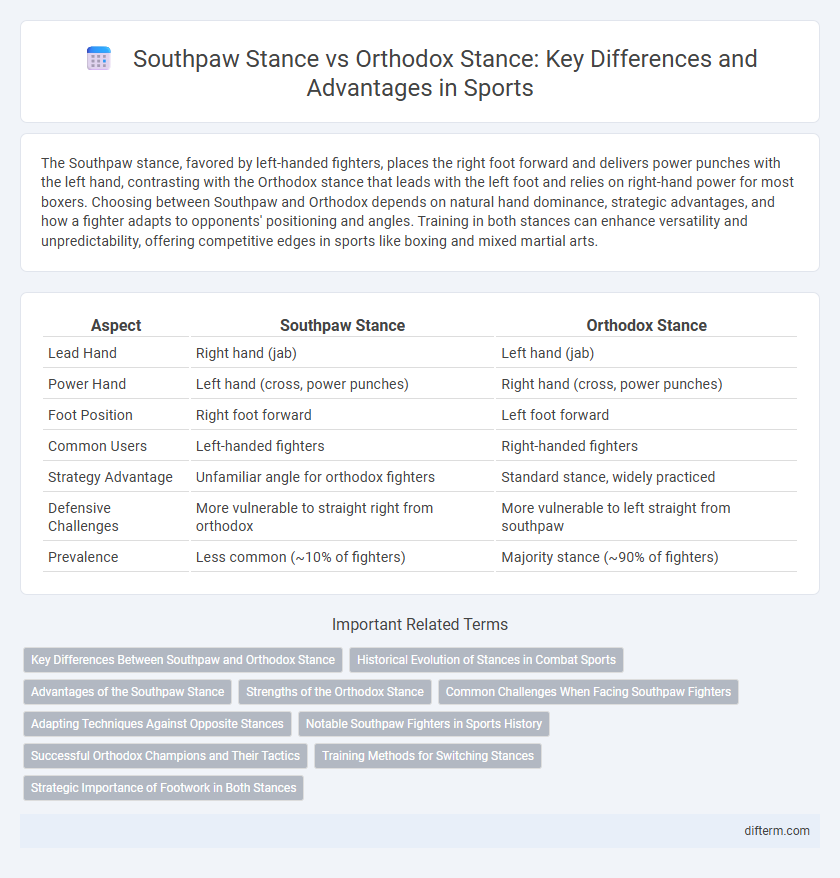The Southpaw stance, favored by left-handed fighters, places the right foot forward and delivers power punches with the left hand, contrasting with the Orthodox stance that leads with the left foot and relies on right-hand power for most boxers. Choosing between Southpaw and Orthodox depends on natural hand dominance, strategic advantages, and how a fighter adapts to opponents' positioning and angles. Training in both stances can enhance versatility and unpredictability, offering competitive edges in sports like boxing and mixed martial arts.
Table of Comparison
| Aspect | Southpaw Stance | Orthodox Stance |
|---|---|---|
| Lead Hand | Right hand (jab) | Left hand (jab) |
| Power Hand | Left hand (cross, power punches) | Right hand (cross, power punches) |
| Foot Position | Right foot forward | Left foot forward |
| Common Users | Left-handed fighters | Right-handed fighters |
| Strategy Advantage | Unfamiliar angle for orthodox fighters | Standard stance, widely practiced |
| Defensive Challenges | More vulnerable to straight right from orthodox | More vulnerable to left straight from southpaw |
| Prevalence | Less common (~10% of fighters) | Majority stance (~90% of fighters) |
Key Differences Between Southpaw and Orthodox Stance
The key differences between Southpaw and Orthodox stances in boxing lie in foot placement and dominant hand positioning, with Southpaw fighters leading with their right foot and right hand, while Orthodox fighters lead with their left foot and left hand. Southpaw stance often presents strategic challenges due to its rarity, causing opponents to adjust their offensive and defensive techniques. Footwork dynamics and punch angles also change significantly, influencing fight tactics and ring control.
Historical Evolution of Stances in Combat Sports
The historical evolution of stances in combat sports reveals that the orthodox stance emerged as the dominant position due to the majority of fighters being right-handed, favoring the left foot forward for power and balance. The southpaw stance, with the right foot forward, gained prominence as left-handed fighters exploited its strategic advantage to create unconventional angles and confuse opponents. Over time, both stances have evolved with training techniques and rules changes, shaping modern combat sports' diverse tactical landscape.
Advantages of the Southpaw Stance
The Southpaw stance offers strategic advantages by positioning a left-handed fighter to exploit angles often less familiar to orthodox opponents, increasing the chances of landing unexpected strikes. This stance enhances defensive capabilities through unorthodox foot placement, creating openings while minimizing exposure to conventional attacks. Southpaw fighters commonly generate more powerful punches with their dominant left hand, leveraging leverage and body rotation unique to this stance for effective offensive maneuvers.
Strengths of the Orthodox Stance
The orthodox stance, dominant among right-handed athletes, offers a strategic advantage through its balance between power and defense, enabling stronger rear-hand punches and solid foot positioning. This stance maximizes the use of the lead left jab for controlling distance and setting up combinations, enhancing offensive versatility. Strength in stability and reach allows fighters in the orthodox stance to effectively counter attacks and maintain pressure in both boxing and mixed martial arts.
Common Challenges When Facing Southpaw Fighters
Orthodox fighters often struggle with the unfamiliar angles and foot positioning when facing southpaw opponents, leading to difficulty in landing effective strikes. The reversal of jab and power hand alignment forces orthodox boxers to adapt their defensive tactics to avoid the southpaw's dominant left cross. Timing and distance judgment become critical challenges, as southpaw fighters naturally exploit openings created by conventional orthodox movement patterns.
Adapting Techniques Against Opposite Stances
Fighters adapting from an orthodox stance to face a southpaw opponent must adjust their footwork to maintain outside positioning, crucial for creating advantageous angles and power punches. Emphasizing defensive maneuvers such as parrying the lead right hand reduces vulnerability, while counters exploiting the open side enhance scoring opportunities. Mastery of timing and distance control becomes essential when engaging opponents with opposite stances to neutralize their dominant hand and maximize offensive effectiveness.
Notable Southpaw Fighters in Sports History
Southpaw stance, characterized by leading with the right hand and right foot forward, has been effectively employed by legendary fighters such as Muhammad Ali, Manny Pacquiao, and Marvin Hagler, leading to their distinctive strategic advantages in boxing. This stance often challenges orthodox fighters, who predominantly lead with their left foot and hand, creating unique angles and defensive opportunities for southpaws during bouts. The success of these notable southpaw athletes in sports history underscores the tactical impact and evolving significance of stance diversity in competitive fighting disciplines.
Successful Orthodox Champions and Their Tactics
Orthodox stance champions like Muhammad Ali and Floyd Mayweather Jr. capitalize on powerful jabs and strong lead right hands, maintaining superior balance and foot positioning to dominate opponents. Their tactics often involve effective counterpunching, precise timing, and strategic use of reach advantage to control the ring. Mastery of defensive techniques combined with calculated aggression enables these orthodox fighters to neutralize southpaw opponents' angles and deliver decisive strikes.
Training Methods for Switching Stances
Training methods for switching between southpaw and orthodox stances emphasize repetitive shadowboxing drills and mirror practice to develop muscle memory and footwork adaptability. Incorporating specialized bag work and partner sparring sessions enables fighters to experience real-time adjustments and improve balance in both stances. Effective coaching techniques also include video analysis and stance-specific conditioning exercises to enhance transition speed and power output.
Strategic Importance of Footwork in Both Stances
Footwork is crucial in both southpaw and orthodox stances, determining balance, mobility, and angles of attack. In the southpaw stance, quick lateral movements and pivoting create openings against orthodox opponents, exploiting their unfamiliarity with left-handed tactics. Orthodox fighters rely on precise foot placement to maintain strong defensive positioning and generate power from the lead leg during strikes.
Southpaw stance vs orthodox stance Infographic

 difterm.com
difterm.com